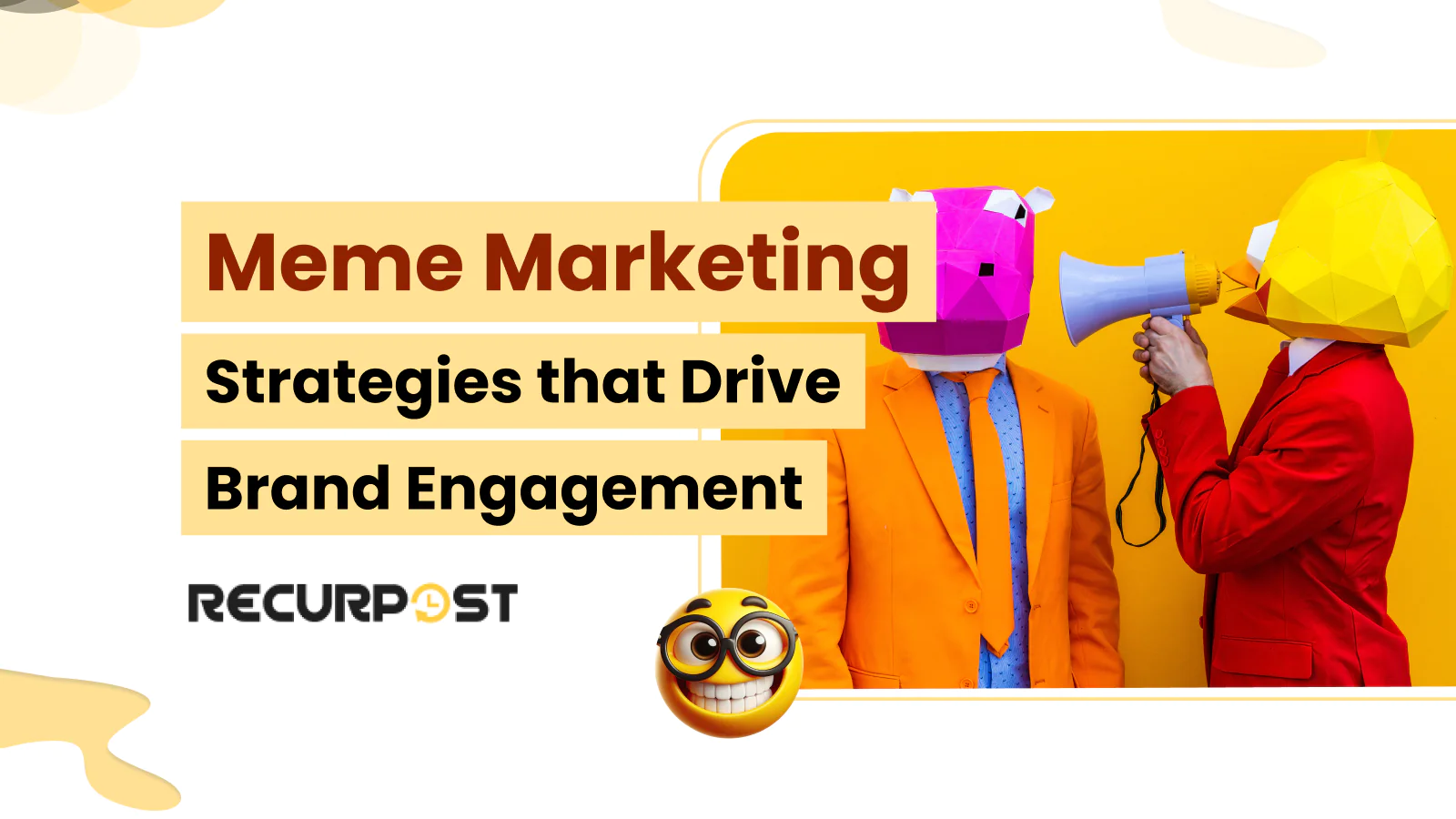Meme marketing connects with audiences in 2025 by using relatable, humorous, and viral memes. Memes move fast across social media, making memes a favorite tool for instant engagement and audience growth.
Marketing agencies and influencers rely on meme marketing for brand visibility and reach. Marketing memes, including digital marketing memes and social media marketing memes, drive brand engagement and boost campaign results.
Meme strategies resonate with Gen Z and millennials: the most active groups online. Social media marketing memes grow brand followers, spark brand awareness, and push engagement rates higher for a low cost. Using meme marketing tools, brands create and schedule meme posts for perfect timing and maximum social media reach.
Learn what memes are, how meme marketing works, and how to create viral memes for 2025. Whether you need tips for a sales goal meme, affiliate marketing meme, or marketing budget meme, this guide unlocks every angle of this marketing for brands aiming for viral status.
What is Meme Marketing?
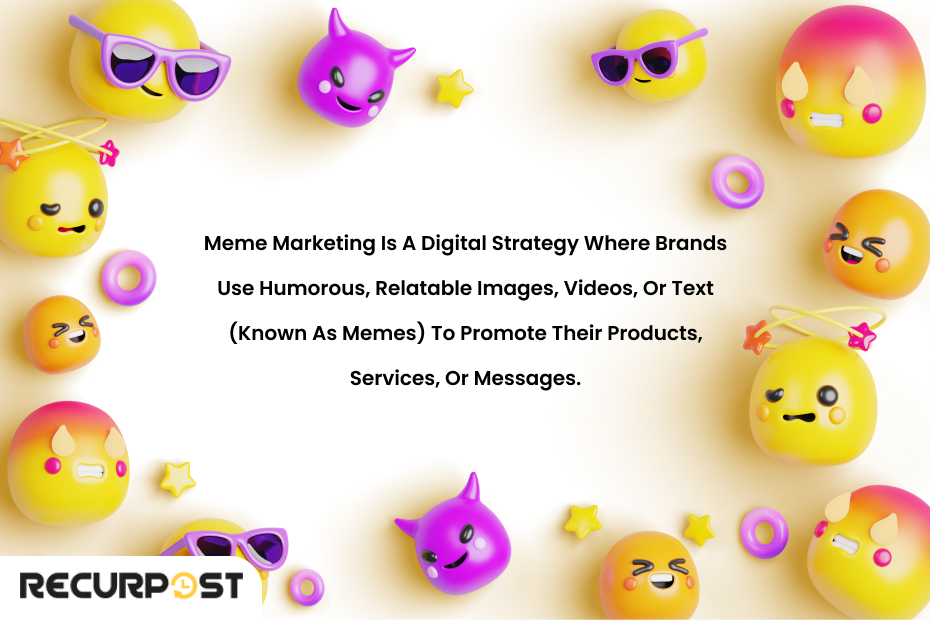
Meme marketing means using memes, funny images, GIFs, or videos to promote brands, products, or campaigns. Marketers rely on meme marketing because relatable memes instantly connect with audiences across social media and boost brand visibility.
A meme is easy to share, funny, and fits right into fast-moving social media feeds. Meme marketing helps brands grab attention and spark viral moments, especially when mixing content marketing memes, influencer marketing memes, and viral meme strategies.
Memes capture cultural and social moments, making them perfect for rapid sharing and engagement. They allow brands to turn pop culture and internet trends into powerful messages that travel fast. Meme advertising links brands to cultural references and creates fast bonds between brands and consumers, making it central to digital marketing campaigns.
Meme marketing connects people through shared emotions and experiences, turning brands into part of the online conversation. It lets brands reach younger audiences: Gen Z and millennials, who lead online trends and boost engagement rates for every meme shared.
Netflix uses influencer marketing memes and digital marketing memes to promote shows, create buzz, and engage huge audiences. This helps brands like Netflix build lasting connections and increase social media engagement.
Best Marketing Memes
The best meme marketing examples prove that it helps brands go viral and reach new audiences. Successful meme marketing turns ads into memes, lifting brand engagement and driving results for social media campaigns.
- Netflix’s “Bird Box” Memes: Netflix used meme marketing to promote Bird Box. Their campaign used viral memes, humor, and suspense to boost streaming numbers and get people talking on every social platform.
- Wendy’s Roasts: Wendy’s is famous for meme marketing that pairs memes with funny tweets. This approach draws meme fans, increases engagement rates, and keeps Wendy’s at the center of internet culture.
- Gucci’s #TFWGucci Campaign: Gucci ran the #TFWGucci meme marketing campaign with top meme creators. By mixing humor with high fashion, Gucci reached younger audiences and grew brand relevance on social media.
- Old Spice’s Viral Memes: Old Spice used meme marketing to transform its brand image, connecting with Gen Z and millennials through viral memes and creative digital content.
Memes vs. Traditional Content
Meme marketing beats traditional content by making brands more shareable and relatable. While typical ads look formal and sales-focused, meme marketing uses humor and internet culture to connect fast. Memes are low-cost and go viral easily, giving brands a wider reach and stronger brand visibility.
Meme advertising replaces expensive influencer marketing and helps marketing campaigns succeed on every social media platform. Brands grow engagement and reach new audiences using memes instead of high-budget traditional ads.
Benefits of Meme Marketing
Meme marketing delivers big benefits for brands, agencies, and influencers on social media. Brands using this marketing see higher engagement rates, wider reach, and lasting audience impact.
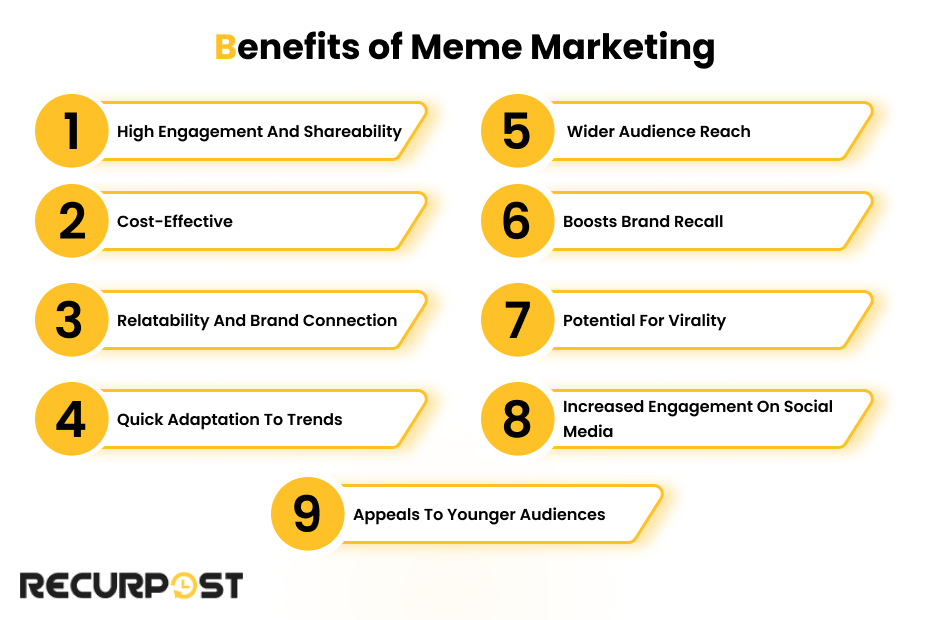
1. Engagement and Shareability
Meme marketing boosts social media engagement and shareability. Engagement memes use humor and relatable moments to spark shares and conversations. Viral memes help brands grow fast, giving them an edge over traditional ads.
Brands gain viral exposure and more social proof using meme marketing, with no need for costly paid ads. Memes travel fast and reach more platforms than classic marketing content.
2. Cost-Effective
Meme marketing costs less than other marketing strategies. Memes are easy to make using free meme tools like Canva and Imgflip. Both local businesses and large brands use memes to stretch their budget and maximize returns.
Creating memes needs almost no investment. Anyone can use a free meme generator or meme template. Meme marketing fits both local campaigns and global brands wanting cost-effective marketing results.
3. Relatability and Brand Connection
Marketing memes help brands show a human side. Meme marketing uses everyday jokes and trends to build strong emotional ties with Gen Z, Millennials, and all digital audiences.
Brands using memes create instant connections by joining cultural conversations and trends. This boosts brand authenticity and helps messages stick with target audiences.
4. Fast Trend Reaction
Memes let brands respond quickly to internet trends. Timely memes boost brand relevance, visibility, and show brands understand digital culture.
Using meme marketing, brands can ride viral trends and boost their presence with current events, helping them stand out as modern and culturally aware.
5. Audience Reach
Meme marketing breaks language and cultural barriers. Memes are easy to share and understand, so they expand reach across all demographics and global markets.
Memes move across platforms and go viral in new markets, often using “know your audience” meme strategies to match content with every demographic.
6. Boosts Brand Recall
People remember brands that use memes. Meme marketing campaigns with clever, funny, or topical content stick in audience minds and boost brand recall.
Consistent marketing builds brand recall, helping brands stay top-of-mind on social media.
7. Viral Potential
A single meme campaign can reach millions. Well-timed memes create viral moments that deliver huge visibility without big ad spend.
The viral reach of memes makes them a top choice for brands seeking fast, wide exposure and big returns.
8. Social Media Engagement
Memes work best on social media platforms, generating likes, shares, comments, and even user-generated memes.
Memes help influencers, digital marketing agencies, and brands boost engagement and grow social proof faster than standard ads.
9. Appeals to Gen Z and Millennials
Meme marketing is a hit with Gen Z and Millennials. Brands use memes to connect with these digital-native groups through humor and informal content.
Younger audiences prefer memes over polished ads, so brands use memes for higher engagement and connection.
In short, meme marketing gives brands a shareable, affordable, and relatable strategy for big gains in brand reach, social media visibility, and engagement with almost no cost.
How to Create Memes That Work?
To create memes that work, brands need a marketing strategy focused on the audience, trends, and brand voice. The best marketing connects with followers by matching the humor, topics, and tone people want.
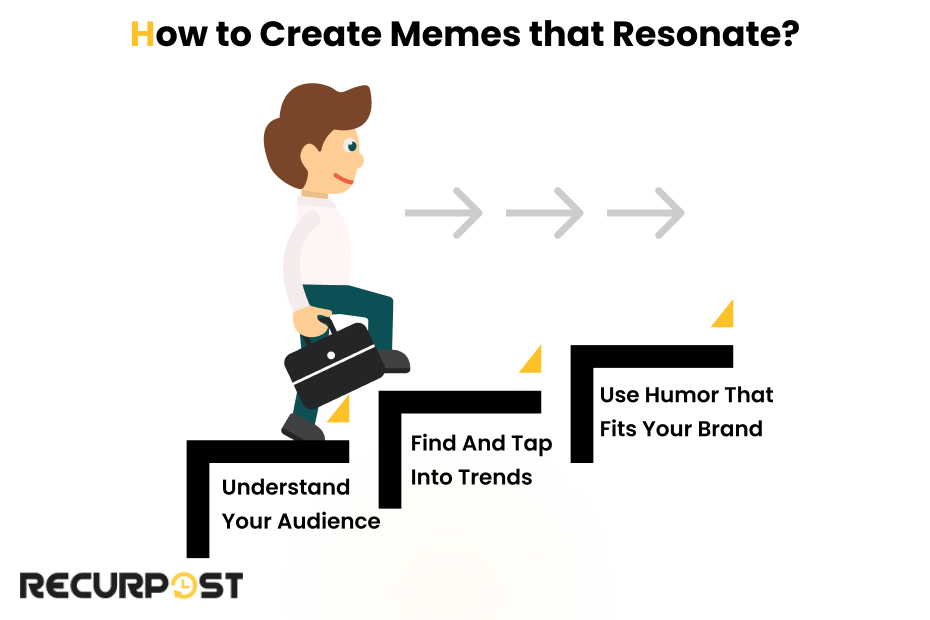
Know your audience
Great memes start with understanding what your followers find funny. Use demographic insights and audience research to spot the memes, humor, and trends your market enjoys.
Gen Z loves niche internet humor, while digital marketing agencies use memes about software bugs or client feedback to build engagement. Brand memes that reflect real industry moments get the highest engagement and shares.
Craft meme marketing campaigns around relatable, real-life situations for your audience. The best memes make people feel seen and boost brand engagement.
Find and ride trends
Effective meme marketing follows trends on TikTok, Twitter, and Reddit. Use Google Trends and social listening to catch viral topics fast. Timely memes linked to pop culture or trending moments drive viral reach.
Use humor that fits your brand
Memes work the best when brand humor matches audience expectations. Choose meme formats and jokes that fit your style and industry. Mixing viral meme templates with brand messaging increases impact and shareability.
Top Meme Marketing Strategies for 2025
Here are the best meme marketing strategies brands will use in 2025 to stand out and reach new audiences. 2025 memes reward brands that move fast, use viral trends, and follow strong marketing strategies.

Keep it simple
Top meme marketing in 2025 uses clear, easy-to-understand memes. Simple meme formats and short captions drive engagement and shareability. The most successful marketing keeps content easy to read, matches meme templates audiences already know, and highlights one clear brand message.
Act fast with trends
Viral meme marketing in 2025 depends on timing. Brands using memes or jumping on fresh internet trends get more reach and engagement. Meme campaigns about current events, like the World Cup, generate more viral traction than outdated memes.
Use humor that fits your brand
Great memes make people laugh, but keep your brand voice strong. Avoid memes that might offend your target audience. Brand memes like Gucci’s #TFWGucci campaign show how mixing brand values and humor builds engagement. The best marketing strategies blend viral meme templates with your brand’s unique message.
Brand success stories
Netflix used memes in the Bird Box campaign to boost views and social media shares. Brands that use current meme formats and relevant humor in their 2025 marketing campaign can reach millions of new fans.
Tools and Platforms for Meme Creation
In 2025, brands need fast, easy-to-use tools to create viral and shareable memes. Here are the top platforms for producing engaging meme content:
Canva
Canva’s meme templates help anyone make viral content quickly. Its drag-and-drop builder lets you add logos or personalize visuals for a polished, on-brand look. Canva works for both beginners and pros looking to share memes or launch new social campaigns.
Imgflip
Imgflip is a go-to meme generator packed with classic and trending templates. You can make memes or GIFs in minutes, ideal for brands or individuals who want quick, relatable content. Imgflip’s straightforward approach fits both personal and business needs.
Supermeme.ai
Supermeme.ai uses AI to speed up the creative process. Marketers and agencies can generate meme captions and original content at scale. It’s perfect for fresh ideas or producing lots of new images quickly.
Adobe Spark
Adobe Spark gives you pro-level control for meme creation. Use its design tools, stock images, and templates to produce custom visuals. This platform is great for companies seeking unique campaigns with a strong visual impact.
Giphy
Giphy lets anyone create and share animated memes and GIFs. Short, looping GIFs are huge for social engagement and often get more shares than static images. Use Giphy to make eye-catching content that grabs attention on every platform.
Best Platforms for Meme Distribution
The best platforms for sharing memes each offer unique ways to build reach and boost engagement:
- Instagram: This is a top pick for visual memes. Viral content spreads fast with features like likes, shares, reels, and stories. Brands and creators can build huge followings by posting the right meme formats here.
- TikTok: The go-to app for video memes and GIFs. The TikTok algorithm loves engagement, pushing trending videos to millions. Memes here can go viral overnight, making it ideal for fast-moving trends and younger audiences.
- Reddit: Known for niche groups and targeted humor, Reddit lets users post memes in subreddits built around shared interests. The right meme can explode in a specific community, giving brands direct access to dedicated fans.
- X/Twitter: Perfect for rapid-fire meme sharing and trending moments. Hashtags and retweets help memes reach wide audiences quickly, especially during live events or viral news cycles.
Distributing memes across these platforms helps brands maximize visibility, connect with new audiences, and stay ahead of trends.
How to Measure Meme Marketing Success?
How do you measure real success in meme marketing, B2B meme campaigns, or even the latest viral meme marketing company efforts? Track these critical metrics to see how your memes stack up:
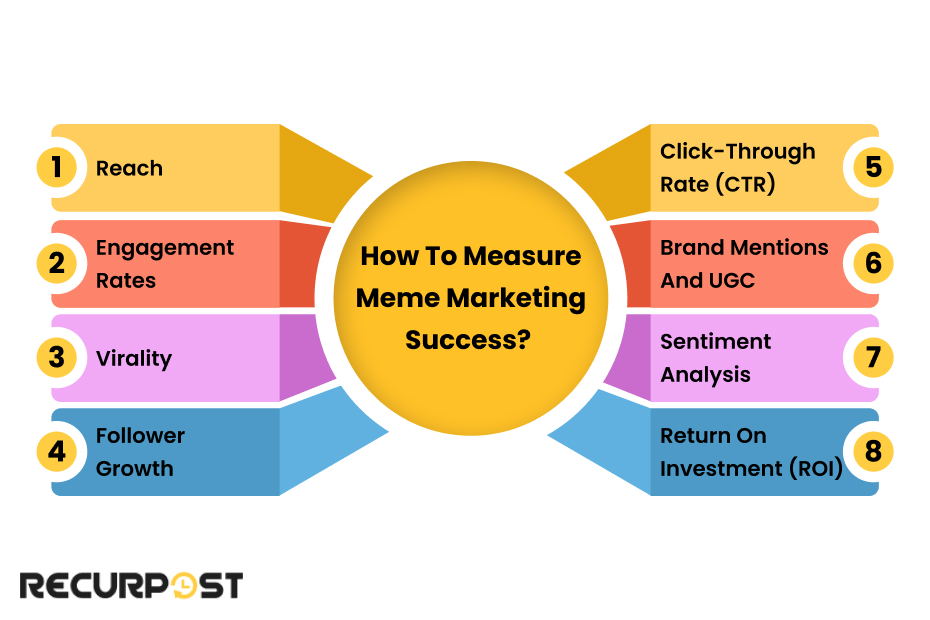
1. Reach
Reach shows how many people see your meme, from niche online communities to huge social platforms. With the right meme generator, you can test new meme trends and target broader audiences. Look for trending hashtags to boost meme visibility and watch your content velocity increase as more people share your brand meme.
2. Engagement Rates
Engagement metrics reveal how much users interact with your memes through likes, shares, comments, retweets, or even tags. Engagement memes, funny marketing strategy meme posts, and relatable memes all help spark user reactions. In B2B meme examples, tagging colleagues can turn a simple meme into a company-wide talking point.
3. Virality
Track virality by how quickly your meme spreads using meme marketing statistics such as shares per hour, unique reposts, or sudden spikes in reach. Viral meme marketing companies rely on content that catches fire fast. Look for user-generated content or brand memes that jump from one platform to another.
4. Follower Growth
Watch for spikes in followers after releasing a meme. It works for both consumer brands and B2B meme campaigns. Growth in followers shows your memetic marketing approach connects, especially if new followers use your meme templates or engage with your brand meme content.
5. Click-Through Rate (CTR)
If your meme links to a landing page or uses a call-to-action, track the click-through rate to measure traffic and real business outcomes. The best marketing strategy meme blends humor and clear CTAs for measurable results.
6. Brand Mentions and UGC
Brand recall gets a boost when fans create and share their own versions of your meme or mention your brand using trending hashtags. UGC (user-generated content) around brand memes signals strong engagement and helps a brand engagement agency track campaign reach.
7. Sentiment Analysis
Use social listening tools to monitor how people feel about your meme. Are they laughing, cringing, or debating its message? Brandwatch and Social Mention can help measure positive versus negative sentiment around your meme trends, keeping your brand alignment on track.
8. Return on Investment (ROI)
ROI for memes is often high due to low cost and high reach. Track how your creative ideas and content velocity (number of new memes posted weekly) drive actual business outcomes. If your campaign leads to increased leads, sales, or brand recall, your memetic marketing efforts are paying off.
By tracking these metrics: reach, engagement, virality, CTR, sentiment, and ROI, you’ll build a full picture of meme marketing success. This approach works for consumer, influencer, and B2B meme examples alike, helping brands refine their meme strategy for even better results in 2025 and beyond.
Risks and Challenges in Meme Marketing
Memes can boost brand recall and spark creative ideas, but they come with risks that brands need to manage carefully, especially as meme trends move fast and public taste shifts overnight.
1. Avoiding Meme Marketing Fails
A common risk is launching a branding meme that feels forced, off-brand, or out of touch with current meme trends. Brands, especially in B2B meme examples, can damage their reputation by misjudging cultural references or targeting the wrong online communities.
Meme marketing fails often happen when humor doesn’t match brand alignment, or a joke misses the mark and sparks backlash. Trending memes that seem funny in one context can backfire in another, so brands need to check the tone, audience, and relevance before posting.
2. Managing Backlash and Protecting Brand Reputation
If a meme is misinterpreted, offends a group, or draws negative press, act quickly to clarify your intent and apologize if needed. Listening to feedback from your audience or brand engagement agency, especially on platforms where memes spread fast, can help you respond before the risk grows.
Learning from meme marketing statistics and other brand meme case studies can help prevent repeated mistakes. Be ready to take down any meme that creates brand risk, and remember: authenticity and cultural sensitivity always win.
3. Balancing Risk and Reward
Every meme carries some risk; what works for one brand might flop for another. Creative ideas are valuable, but balancing bold meme campaigns with careful brand alignment keeps your message on track. Using trending hashtags, following new meme trends, and watching online conversations can reduce the risk and help your brand stand out for the right reasons.
By staying tuned in to online communities, tracking sentiment, and reacting quickly, brands can enjoy the rewards of meme marketing while minimizing the risk of a meme misfire.
What is the Future of Meme Marketing for 2025?
The future of meme marketing brings rapid change, bold creative ideas, and new approaches for brands, agencies, and even B2B meme examples. Here’s what brands and marketers can expect:
Short-Lived Content & Content Velocity
Memes will keep their short shelf life as content velocity increases in 2025. Trending memes, meme trends, and even the most viral brand memes may only last a few days. Successful brands and viral meme marketing companies will need agile teams or meme generators to spot, create, and share new memes faster than ever.
AI-Generated and Personalized Memes
AI-generated memes will shape the next wave of memetic marketing. Tools like Supermeme.ai and automated GIF meme marketing solutions will let brands and influencers personalize memes for trending hashtags, audience interests, or even B2B meme campaigns in real time. This approach allows brands to tap into online communities with highly targeted, culturally relevant meme content.
Stronger Brand Alignment and Brand Recall
As meme culture evolves, brand alignment will matter more: brands that match their meme style to their voice and audience will enjoy stronger brand recall and fewer meme marketing fails. In 2024 meme marketing, we saw a rise in creative ideas for niche markets; expect more industry-specific and B2B meme examples in 2025.
Cultural References and Community Building
Online communities and cultural references will continue to be central to meme marketing strategies. Memes will connect brands to audiences not just through humor, but by participating in meaningful digital conversations. Marketers will use brand memes and trending hashtags to drive engagement and build lasting relationships.
The Bottom Line
Meme marketing continues to gain ground for brands, agencies, and even B2B companies, with numerous examples of successful B2B memes. By using trending memes, the right marketing meme template, and strong brand alignment, you can boost reach, brand recall, and engagement. Relatable memes, built on creative ideas and cultural references, are the secret to content that gets shared and remembered across every social platform.
FAQs on Meme Marketing
1. What makes a meme go viral?
Viral memes are typically timely, simple, and relatable. They often connect with shared cultural experiences or current trends.
2. Can memes work for all industries?
Yes, but success depends on understanding your audience. For some industries, humor may need to be more subtle or industry-specific.
3. What are the best tools for creating memes quickly?
Tools like Canva, Imgflip, and Supermeme.ai are great for fast meme creation.
4. How can I avoid offensive memes?
Avoid topics that are overly sensitive or controversial. Stay on-brand and always review memes before posting.
5. Is meme marketing strategy a long-term goal?
Meme marketing strategy can be part of a broader social media content suggestions marketing strategy, but it’s important to evolve with trends and avoid over-relying on memes for engagement.
6. How Do People Make Memes?
People make memes using simple tools and creativity. Here’s how:
Choose a Template – Use popular meme images or create your own visuals.
Add Text – Add funny or relatable captions that align with the image. Tools like Canva, Meme Generator, or Photoshop make this easy.
Keep It Short – Memes are more impactful with brief, witty text.
Share It – Post it on social media platforms to engage your audience.

Ruchi Dhimar is a skilled content writer with 5 years of experience. She is passionate about crafting compelling narratives, specializing in writing content for different industries.

